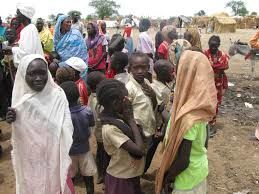Trauma
Refugee Children Need Our Help
Can we turn our backs on the most vulnerable?
Posted November 14, 2017

The images are stark and omnipresent. Long lines of desperate people trudge through mud. In vast tent cities, barefoot, skinny small boys and girls with huge eyes stare out at us. In bombed out cities, malnourished children and adults wander dazed, trying to scavenge something in the wreckage. We see these images so often, many of us are becoming inured, turning away in hopelessness. At the same time, immigration has increasingly become a lightning rod for political and cultural friction. As the refugee crisis mounts throughout the globe, relatively safe and rich nations are shutting their gates in the name of security, cultural resentment and economic anxiety. For example, in the U. S., between 1990 and 1995, an average of 112,000 refugees per year were granted asylum. In fiscal year 2016, however, that number was down to 84,995 refugees. In 2017, the current U. S. administration is trying to push that number yet lower, with some advocating zero admissions. At the same time, the refugee crisis, fueled by the Afghanistan, Iraq and Syrian wars, has only grown. There are now 65 million desperate people worldwide, on the move fleeing war, famine and persecution.
Refugees from war-ravaged, violence-wracked areas continue to flee. The most vulnerable of them, children, often unaccompanied, wash up on our shores (and those of other countries) seeking asylum. By one estimate, over 40% of refugees admitted to the U. S. were children, as of 2012. Psychologists, among other professionals, have been documenting adverse effects on refugee children, before, during and after their flight. While we can easily imagine the multiple traumas of forced immigration, often amid war and violence, it is important to have clear empirical evidence. Such research also allows us to see sources of resilience and strength that many refugee children bring to their ordeal. Studies help us target programs and resources and importantly, help advocate for refugee relief.
Not surprisingly, interviews with refugee children find high levels of trauma, depression and anxiety. Unaccompanied children are especially affected, with up to half exhibiting post-traumatic stress disorder (PTSD), clinical depression or severe anxiety. Children arriving with family members often show signs of trauma as well. They experience nightmares, show severe anxiety in clinging to parents, and have psychosomatic symptoms.
In the U. S. general population of children, PTSD rates are about 5% and depression about 11%. While such rates are unacceptably high, among refugee children to the U. S., PTSD rates were 54% and depression 30%, in a recent assessment. Refugee children also often are suffering from other physiological and emotional problems. For example, in one study, children arriving as refugees to the Netherlands had experienced, on average, six stressful life events (the maximum number on the Stressful Life Events Scale is 12). The most common were hunger, extreme poverty, bombing, witnessing street killings, and experiencing sudden home searches by hostile authorities or gangs. This was three times as many stressful life events as reported by Dutch children of the same age.
Many refugees are from ethnic or religious groups that experience discrimination, harassment and sometimes forced expulsion from their home countries. For example, Somali Bantu refugees, 12,000 of whom were admitted to the U. S. in 2003, had been traditionally treated as slaves in Somalia. In the tiny country of Bhutan, ethnic Nepali were expelled in the 1990s and spent nearly 20 years in refugee camps before about 75,000 were settled in the U. S. from 2008 to the present. Currently, the Rohingya, a Muslim minority in Myanmar (Burma), have been victims of a vicious government campaign of ethnic cleansing, causing over 600,000 to flee over the border to Bangladesh, a poor country ill equipped to shelter and feed them.
The flight itself is another major source of trauma. A study of Cuban refugee children who arrived in the U. S. by boat or raft, most unseaworthy, found that a third feared they would die during the passage. As the plight of the Rohingya shows, the process of leaving one’s home can become an extended odyssey of wandering, temporary shelter, limbo in camps, and sometimes forced repatriation. In the process, children are at risk of separation from parents or other family members, violence and extreme deprivation. They may witness others dying or being abandoned on the journey. They are at risk of exploitation by human traffickers. By one 2012 estimate, 29% of all refugee girls had been sexually assaulted or raped by the time of their arrival in the U. S.
Studies of refugee children find that stressors often co-occur, and thereby multiply in intensity. As an example, one study found that 30% of arriving refugee children in the U. S. had suffered domestic abuse within their families along with exposure to war and political violence.
Sources of resilience. There is wide individual variation in how refugee children experience their journey and their adaptation to a new culture and society. As one would expect, children who come with family members, especially parents, tend to be at lower risk of trauma than unaccompanied children. In addition, more affluent families often can take more resources with them, shorten the journey and use skills to adapt more quickly. Family cohesion and support are important, as refugee families are at heightened risk for domestic abuse.
The majority of refugee children, given adequate support and welcome, adapt quickly. The innate resilience of youth works in their favor. Even during the early days and months of adjustment, refugee children who have experienced trauma are actually less likely than native born children with trauma histories to run away from home, commit crimes or engage in drug or alcohol use.
Psychologists and other clinicians have important roles to play as advocates for refugees, especially children. Mental health professionals can make it a priority to not only address the needs of refugee children, but also inform an often distrustful and weary public about these children. There is a moral call to action. Unfortunately, this seems to sway few in the public arena. Practical and strategic self-interest also lines up with help for refugees. Leaving millions to languish in transit camps or marooned stateless between borders lays fertile ground for despair and radicalization, further destabilizing conflict zones. Ultimately, the ragged child staring out at the camera beside a refugee tent is our child.
References
van Os, E. C. C., et. al. (2016). Knowledge of the unknown child: A systematic review of the elements of the best interest of the child assessment for recently arrived refugee children. Clinical Child Family Psychology Review 19, 185-203.
Betancourt, T. S., et. al. (2012). Trauma history and psychopathology in war-affected refugee children referred for trauma-related mental health services in the U. S. Journal of Traumatic Stress 25, 682-690.


